
Achieving Less with Much Less.
, .
In 1982 the docks at Salford Quays closed. After nearly a century, the industrial era achievement of running an inland seaport at Greater Manchester was over.
In Leeds, at a similar time, after a much longer history, and in not too dissimilar circumstances, New Dock closed. The upper part of the Aire and Calder Navigation connecting the city centre to the North Sea became a route used purely for leisure.
In Greater Manchester, the Salford Quays development was being planned. In Leeds, work on what is today called Leeds Dock accelerated.
Regeneration
The plans evolved in similar ways.
After making the heavily polluted land safe there would be flats, offices, entertainment, big car parks, and shops. There would be still water at the heart of both sites, a relative novelty in two cities a long way from the sea.
Later, flagship national government institutions would arrive. The UK’s Royal Armouries Museum moved from London and opened at Leeds Dock in 1996. The Imperial War Museum North opened in Salford Quays in 2002.
At this time the Leeds economy was 89% as strong as the UK average compared to just 87% for Greater Manchester. It was not clear which would end up as the North’s most economically important city, nor which regeneration effort would achieve most success.
The work continued.
Perhaps to prove that relocations weren’t just about war, the BBC decided to move some of its operations from London to Salford Quays in 2006. Channel 4 have run a studio near Leeds Dock since 2022.
Education grew as a feature of both sites. In Salford we find The University of Salford and more recently University Technical College (UTC) MediaCity. In Leeds there’s The Ruth Gorse Academy, UTC Leeds, Leeds City College, and the Leeds College of building.
Transport
While most interventions in Salford Quays and Leeds Dock have mirrored each other, with varying scales of ambition and degrees of success in each place, transport has seen a large divergence.
Both sites are well connected to the motorway network but the plans for high density development meant that public transport would be required to supplement this. The freight railway line to Salford Docks had been closed in 1963 and Hunslet Goods station in Leeds had closed in 1976. Salford Corporation tramways and Leeds Corporation tramways which had skirted the sites were long gone.
Greater Manchester convinced the UK government to help it start rebuilding its tram network.
Salford Quays Metrolink stop opened in 1999. More stops and a second line have opened since. Imperial War Museum’s tram stop in 2020 is the latest addition. A tram from Salford Quays to St. Peter’s Square in the centre of Manchester runs every 12 minutes from 6am to midnight. It reliably takes just 14 minutes.

In Leeds nothing was built.
In each of the three decades since regeneration began — the 1990s, the 2000s and the 2010s — similar investment that would have led to there being a tram stop at Leeds Dock was rejected, cancelled, or blocked by the UK government.
The alternatives are a taxi (it’s a small boat) that takes nearly half an hour to reach Leeds station and runs every half an hour between 10am and 6pm. Or the 29 bus which runs via the city centre to the University once an hour. It is almost always heavily delayed at peak times.
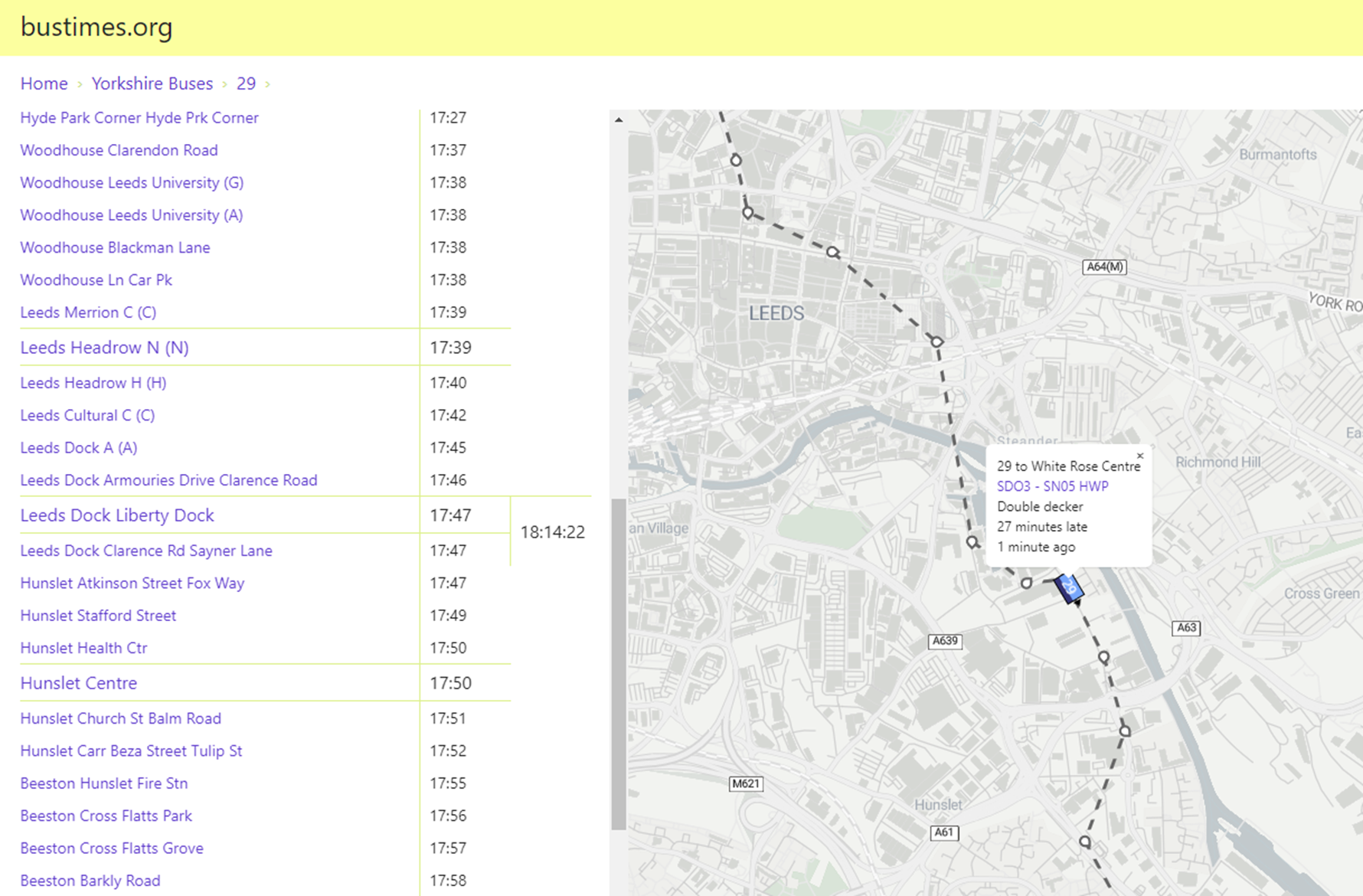
There is no city in Western Europe, North America, or Australia bigger than Leeds that doesn’t have a tram or a metro. We are assured that this time, in the 2020s, it will be fourth time lucky for Leeds. I am sceptical especially with both NPR (a new railway to Manchester via Bradford) and HS2 (a new railway to Birmingham and on to London) both recently cancelled by a government that had promised with as much insistence that they now use to promise a mass transit system for West Yorkshire.
Divergence
The other large divergence between Salford Quays and Leeds Dock has been their success.
As offices, studios, restaurants, bars, and other employers have thrived, the economy of Salford Quays has doubled in size over two decades. Meanwhile at Leeds Dock waves of fashion shops, a casino, restaurants, cafes, bars, and offices have opened and closed as a lack of customers and the inability of employees to get to the site have led to failure. The economy of Leeds Dock is no larger today than it was two decades ago. The economy of Salford Quays today is nearly ten times as large.
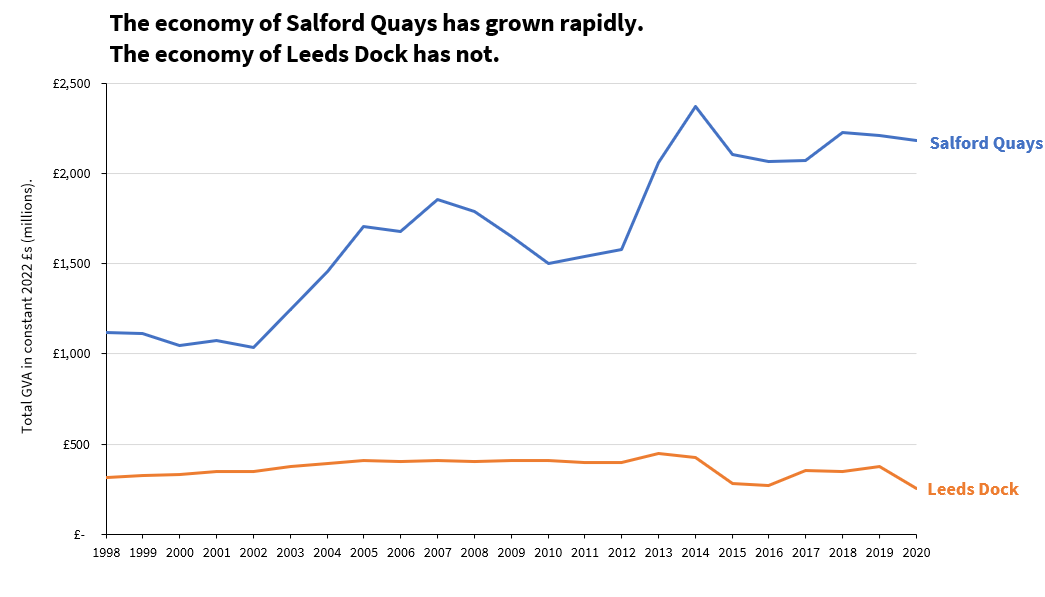
The popopulation of Salford Quays is nearly twice as high, and property values approximately 25% higher reflect the desirability of the location.
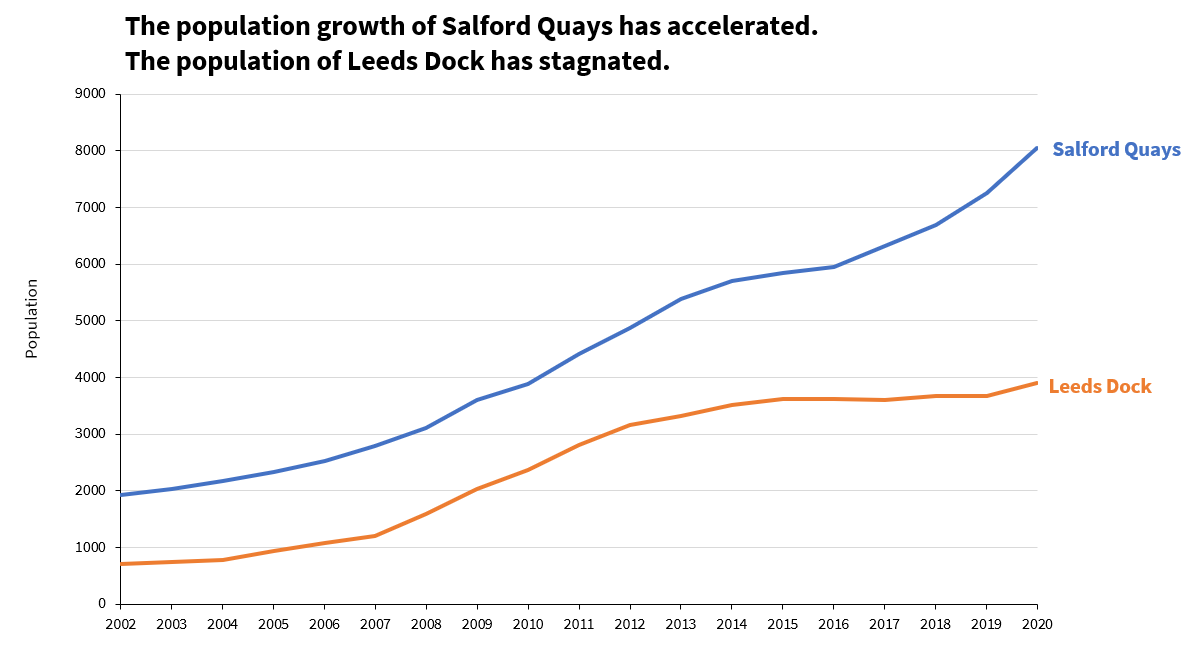

Greater Manchester’s economy has overtaken and pulled ahead of West Yorkshire’s. Almost uniquely among large English cities it has managed to avoid falling further behind the rest of the UK’s economy.
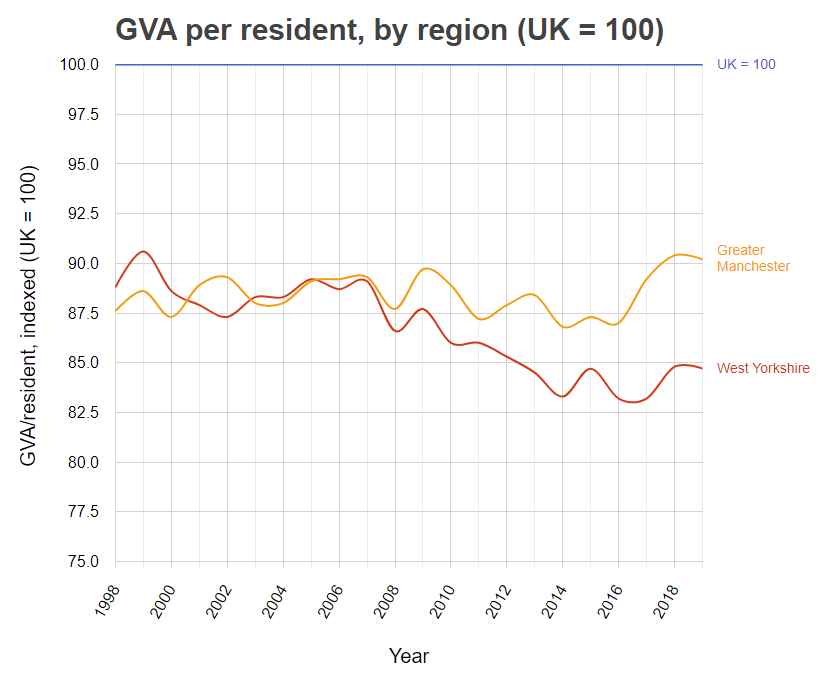
A reasonable estimate is that the success of Salford Quays compared to Leeds Dock accounts for a quarter of the overachievement of Greater Manchester. Other sites such as Eastlands, Castlefield, Ancoats, and Manchester Airport — all connected to the city by Metrolink — probably contribute too.
Complex and nuanced, but mostly simple.
Of course economic growth has many contributing factors, including luck. We cannot know what proportion of Salford Quays’ outperformance of Leeds Dock is because the former was connected to its wider city with a tram while the latter was not.
Many economic researchers indulge in ever more complex attempts at normalising for skills, standardising for past performance, considering displacement, and much more. They hope to add enough complexity to their consideration of economic growth that they can uncover a formula that explains the observed success of some places and the failures of others. Often it seems that they add so much complexity that their methods can never hope to come to any statistically-significant conclusions. I am capable of keeping up with that if I must.
But I think that living through the divergence in the fortunes of these two regeneration projects, while growing businesses in Leeds and living in Manchester, provides at least as much chance to understand what’s going on. I know why Leeds Dock has so far failed because the businesses and people of Leeds who have made it a failure by ignoring it tell me. When we were searching for offices for our expanding businesses, we quickly ruled out offices at Leeds Dock because of its inaccessibility. Things don’t always have to be complex and nuanced. Sometimes the obvious answer isn’t the whole answer, but it is still a big part of it. A place that people can’t get to in a city won’t succeed.
Still a great place for growth.
Leeds Dock is a comparative failure, for now, but it could still quickly become a success. Leeds has been a very well run and pro-growth council for decades. It may have fallen behind Manchester, but it remains the second strongest big city economy in England outside of London.
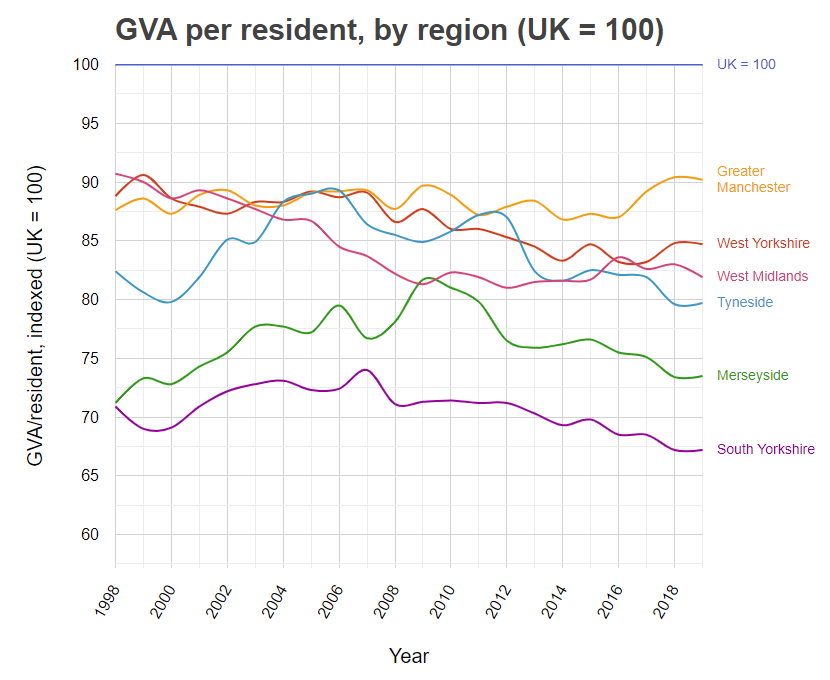
The city’s strengths, particularly in data-related parts of financial and business services, entertainment, and health, are not just aspirational marketing slogans. Core parts of the UK’s world-leading strengths in these fields are reliant on technology, companies, and expertise in Leeds. Indeed my company The Data City here in Leeds is among the world leaders in quantifying these strengths and their value.
Many of those companies are expanding. Most could expand quicker with the same kind of assistance that let companies in Greater Manchester expand quicker when the investment in places like Salford Quays happened.
Leeds has achieved less with much less investment than it would have been prudent to invest. We should expect it to achieve more if we choose to give it the right backing now.